2020-01-02 - Nº 244
Editorial
Esta é a Newsletter Nº 244 que se apresenta com o mesmo formato que as anteriores. Se gostar da Newsletter partilhe-a!
Todas as Newsletters encontram-se indexadas no link.
Esta Newsletter tem os seguintes tópicos:
Esta é a primeira newsletter de 2020 e faz hoje 100 anos que nascia Isaac Asimov, este autor de ficção cientifica é extraordinariamente conhecido pela sua obra extensa de mais de 500 livros. Juntamente com Arthur C. Clack e Robert A. Heinlein é considerado um dos três maiores escritores de ficção cientifica de todos os tempos. Ficou igualmente conhecido por ter enunciado as três leis da robótica que governam a ética dos robôs face aos humanos. As regras foram introduzidas numa pequena história designada por "Runaround", em 1942, sendo posteriormente incluídas na colecção "I, Robot". Faz igualmente anos hoje que nascia Charles Hatchett. Ele foi responsável pela descoberta do elemento químico nióbio. Rudolf Clausius, um dos fundadores da termodinâmica também faz anos que nasceu, em 1822, publicou em 1850 os conceitos básicos da segunda lei da termodinâmica - "A quantidade de entropia de qualquer sistema isolado termo-dinamicamente tende a incrementar-se com o tempo, até alcançar um valor máximo". Não menos importante é Donald B. Keck, que faz anos hoje que nasceu, em 1941 e é responsável pela invenção da guia de onda óptica de sílica fundida mais conhecida por fibra óptica. Maurer, Keck, e Schultz resolveram o problema que anteriormente impedia a utilização desta tecnologia. Actualmente um cabo de fibra óptica consegue transportar a maior distância cerca de 65.000 vezes mais informação que um cabo de cobre.
Na newsletter desta semana ficámos a saber que o matemático e cientista da computação Donald Knuth, conhecido pela sua colecção de livros "The Art of Computer Programming" (TAOCP), considerada por muitos a bíblia da ciência da computação, usou um número muito particular ao longo dos seus livros. Ele usou o numero pi de forma explicita e também de forma relativamente despercebida ao longo dos seus livros divertindo-se com isso. Na sua apresentação anual ele falou de forma apaixonada do número pi e das suas curiosidades.
Também nesta semana que passou e mesmo no final do ano a segunda plataforma WindFloat Atlantic das três que compõem o projecto saiu no passado domingo do porto de Ferrol para uma localização a cerca de 20 km da costa portuguesa, perto de Viana do Castelo. O transporte das três estruturas flutuantes do WindFloat Atlantic é um marco em si, pois evita a necessidade de rebocar embarcações projectadas especificamente para esse processo e possibilita a replicação do projecto em outras geografias. Uma vez operacional e com capacidade instalada de 25 MW, o parque eólico poderá gerar energia suficiente para abastecer o equivalente a 60.000 utilizadores por ano.
Na newsletter desta semana são apresentados diversos projectos de maker assim como diversas noticias de novidades que ocorreram nesta semana que passou.
Asimov disse "A frase mais emocionante de se ouvir na ciência, a que anuncia novas descobertas, não é 'Eureka!' mas 'Isto é engraçado ...'"
Um excelente ano para todos!
 João Alves ([email protected])
João Alves ([email protected])
O conteúdo da Newsletter encontra-se sob a licença  Creative Commons Attribution-NonCommercial-ShareAlike 4.0 International License.
Creative Commons Attribution-NonCommercial-ShareAlike 4.0 International License.
Novidades da Semana

Donald Knuth’s 2019 ‘Christmas Tree Lecture’ Explores Pi in ‘The Art of Computer Programming’
"For a quarter of a century, Stanford’s great computer science professor emeritus has been delivering a special “Christmas Tree” lecture each December. Now approaching his 82nd birthday, Donald Knuth emerged again on Dec. 5 for the 25th annual installment — and took the time to remind his audience that he’s also still diligently writing the book he’s been working on for the last 57 years. That book is The Art of Computer Programming, revered among programmers as one of the most comprehensive analyses of algorithms available. The book is “widely considered to be among the best scientific writings of the century,” according to one web page at Stanford. “My full-time writing schedule means that I have to be pretty much a hermit,” writes Knuth on his personal site. So it’s a doubly special occasion when the great man makes a live appearance." [...]

The second platform of the WindFloatAtlantic has set off from the Port of Ferrol
"This operation builds on the successful installation of the first platform in October and will follow the same route from the Galician port to its final destination 20 km off the Portuguese coast. Windplus is a consortium made up of EDP RENEWABLES, ENGIE, REPSOL and PRINCIPLE POWER. WindFloat Atlantic has taken another important step towards entry into operations. The second of the three platforms, which make up the project, has left the Port of Ferrol for its final destination 20 km off the coast of Portugal at Viana do Castelo.. Upon arrival to the project site, it will be installed next to the first floating platform, which has the exact same dimensions: 30 metres in height and with a 50-m distance between each column. The third and final platform, once it arrives to the site, will complete the first floating offshore wind farm in Continental Europe." [...]
Outras Notícias
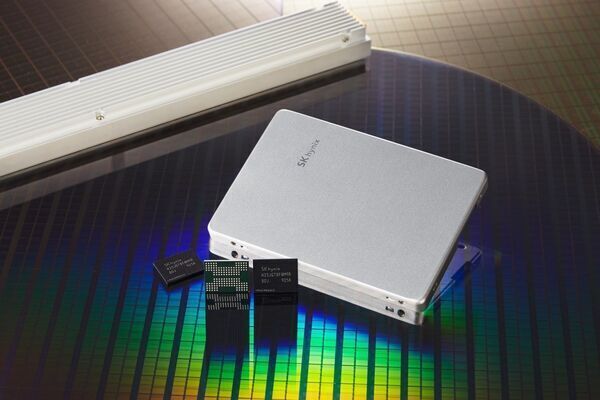
SK hynix to Introduce Consumer PCIe NVMe SSDs at CES 2020
"SK hynix Inc., a global semiconductor maker based in Korea, is set to introduce its newest offering of “Gold P31” and “Platinum P31” PCIe NVMe Solid State Drives (SSDs) at the Consumer Electronics Show (CES) 2020, which will be held on January 7–10 in Las Vegas, Nevada. The drives are built with SK hynix’s 128-layer 4D NAND flash, only six months after the Company announced the mass production of the world’s first and highest vertical stack for NAND flash, demonstrating the chipmaker’s technological edge. As a leading manufacturer of memory chips, SK hynix builds and supplies its own DRAM and NAND flash devices, as well as SSD controllers designed and developed in-house. The company has a proven track record as a major supplier to global OEMs including top-tier PC makers, who have trusted and purchased SK hynix’s SSDs for nearly a decade now. As a next step, SK hynix is now expanding into the consumer market with its newest drives. “SK hynix’s new SSDs were built as premier solutions for users seeking advanced performance to run multimedia tools and the most demanding of PC games,” said the Company’s spokesperson." [...]

The Open Connectivity Foundation Introduces World’s First International Standard for Smart Home; Will Demonstrate New OCF Universal Cloud Interface-based Smart Home Solutions at CES 2020
"The Open Connectivity Foundation (OCF), a leading Internet of Things (IoT) standards body, today announced that products from BSC Computer GmbH, COMMAX, Haier, LG Electronics, Resideo, Samsung Electronics and SURE Universal will be showcased in completely interoperable smart home demonstrations at the OCF IoT Breakthrough press event at the Barrymore Restaurant in Las Vegas on January 6, 2020, from 3–6 p.m. PST. These devices will complete OCF 2.1 certification in 2020, ensuring robust and secure connectivity between devices. Many of these and other industry-leading OCF member companies will be commercially launching products based on the OCF specification in 2020. Research shows that revenue from the smart home market is expected to show an annual growth rate of 17.6 percent, resulting in a global market volume of more than $141 billion by 2023. As the smart home market continues to rapidly grow, secure interoperability will be key in making the IoT successful. The OCF Certification Program helps manufacturers create products that “just work” with other OCF Certified IoT devices regardless of their form factors, operating systems, service providers or transports." [...]

Toshiba Delivers Mobile Hydrogen Fuel Cell System to Fuel Cell Ship
"Toshiba Energy Systems & Solutions Corporation (hereinafter “Toshiba ESS”) today announced that the company has delivered a mobile 30kW hydrogen fuel cell system, which volume per unit power output is reduced to 1/3 compared to the stationary fuel cell systems, to a fuel cell ship. The fuel cell ship, which passed the Temporary Navigation Permit Inspection of Japan Craft Inspection Organization on October 30, has started demonstrations of the verification by NREG TOSHIBA BUILDING Corporation*1 and Tokyo University of Marine Science and Technology (hereinafter “TUMSAT”). The newly mobile 30 kW pure hydrogen fuel cells system developed by Toshiba ESS will be available to install for vessels, railways and trucks. Hydrogen is used as fuel, allowing electricity to be generated without CO2. The system makes lower noise compared to standard ship engines, and it starts generating power in one minute at the shortest. This time, Toshiba ESS can reduce the volume per unit power output to 1/3 compared to the stationary fuel cell systems due to its simplified design and package improvement." [...]
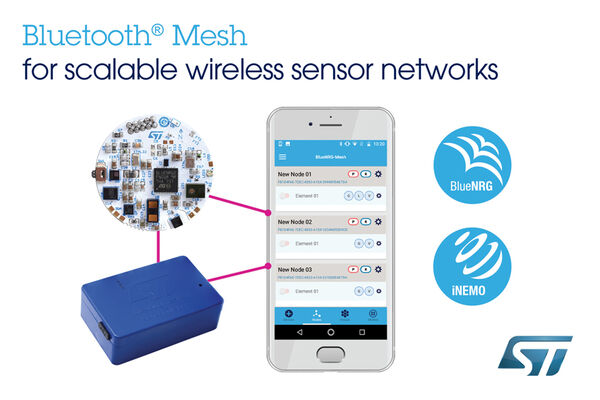
STMicroelectronics Unleashes Full Power of Bluetooth® Mesh to Enable Scalable Wireless Sensor Networks
"Demonstrations of Bluetooth mesh solutions for smart-building/smart-factory automation solutions on display during CES 2020 With the release of Bluetooth® mesh software stacks for the BlueNRG family of Bluetooth Low Energy chips and modules, STMicroelectronics will demonstrate the many capabilities of Bluetooth mesh networks enabled by the new software during CES 2020, the Consumer Electronics Show, in Las Vegas (Jan 7-10). The demonstrations show how ST’s BlueNRG mesh software and proven Bluetooth Low Energy-enabled Wireless Sensor Platforms, together, enable to form pervasive and scalable networks of sensors and actuators that can support new use cases extending throughout smart buildings and smart factories. A 20-node Bluetooth mesh network, to be demonstrated at a private suite during CES, comprises tiny battery-powered BlueNRG-Tile wireless sensor nodes, STM32L4-powered SensorTile.box modules, and sensor-evaluation boards, cooperating to let any network node communicate with any other node in the network and with a connected smartphone. The demonstrations showcase the breadth of smart-building and factory-automation scenarios for low-power battery-operated sensor nodes including motion sensing, voice-controlled smart lighting, proximity sensing, temperature and vibration sensing, as well as powerful edge-computing-enabled nodes for HVAC-system monitoring, and network-device provisioning. In all cases, the demos show a fully operational BlueNRG-Mesh network, monitored and controlled via smartphone/tablet app. ST’s mesh software and BlueNRG devices are certified according to Bluetooth SIG specifications, confirming support for defined node features as well as interoperability with other Bluetooth Low Energy (LE) devices." [...]

NASA’s SDO Sees New Kind of Magnetic Explosion on Sun
"NASA’s Solar Dynamics Observatory has observed a magnetic explosion the likes of which have never been seen before. In the scorching upper reaches of the Sun’s atmosphere, a prominence — a large loop of material launched by an eruption on the solar surface — started falling back to the surface of the Sun. But before it could make it, the prominence ran into a snarl of magnetic field lines, sparking a magnetic explosion. Scientists have previously seen the explosive snap and realignment of tangled magnetic field lines on the Sun — a process known as magnetic reconnection — but never one that had been triggered by a nearby eruption. The observation, which confirms a decade-old theory, may help scientists understand a key mystery about the Sun’s atmosphere, better predict space weather, and may also lead to breakthroughs in the controlled fusion and lab plasma experiments. “This was the first observation of an external driver of magnetic reconnection,” said Abhishek Srivastava, solar scientist at Indian Institute of Technology (BHU), in Varanasi, India." [...]
Ciência e Tecnologia
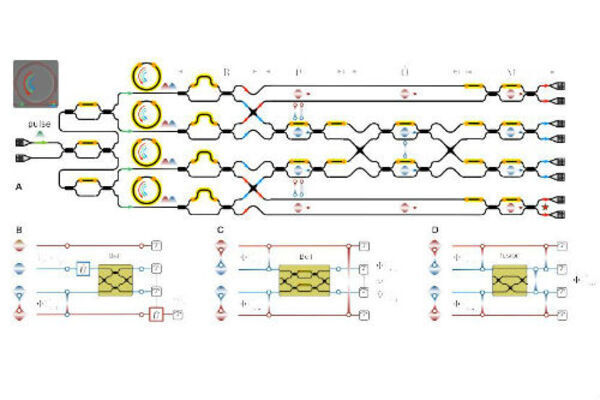
First chip-to-chip quantum teleportation harnessing silicon photonic chip fabrication
"The development of technologies which can process information based on the laws of quantum physics are predicted to have profound impacts on modern society. For example, quantum computers may hold the key to solving problems that are too complex for today’s most powerful supercomputers, and a quantum internet could ultimately protect the worlds information from malicious attacks. However, these technologies all rely on ‘quantum information’, which is typically encoded in single quantum particles that are extremely difficult to control and measure. Scientists from the University of Bristol, in collaboration with the Technical University of Denmark (DTU), have successfully developed chip-scale devices that are able to harness the applications of quantum physics by generating and manipulating single particles of light within programmable nano-scale circuits. These chips are able to encode quantum information in light generated inside the circuits and can process the ‘quantum information’ with high efficiency and extremely low noise. This demonstration could enable a significant boost in the ability to produce more complex quantum circuits that are required in quantum computing and communications." [...]

Using light to encrypt communications
"Researchers of the UT found a new way to protect data from attacks with quantum computers. As they published today in New Journal of Physics. With quantum computers on the rise, we can no longer exclude the possibility that a quantum computer will become so powerful it can break existing cryptography. Single particles of light are already being used to protect data but the transmission of 1 bit per photon is slow. Pepijn Pinkse led the experiment to increase the transmission speed up to 7 bits per photon. Computers use cryptography to secure their communication." [...]

The Internet of Things by satellite will become increasingly accessible
"Thanks to the implementation of advanced random access schemes using efficient, low complexity algorithms. According to a study published in International Journal of Satellite Communications and Networking of which one of its authors is Giuseppe Cocco, a researcher at the DTIC and at the German Aerospace Center (DLR). ince some years ago, the Internet of Things (IoT) has been a constantly evolving reality. The possibility that machines (nodes) can communicate with each other has paved the way for applications that promise to have a profound impact on our lives. They include smart farming, home automation and communication between vehicles. One of the key elements of the IoT is wireless communication between machines, known as Machine-to-Machine (M2M) Communication." [...]

Paving the way for spintronic RAMs: A deeper look into a powerful spin phenomenon
"Scientists at Tokyo Institute of Technology explore a new material combination that sets the stage for magnetic random access memories, which rely on spin—an intrinsic property of electrons— and could outperform current storage devices. Their breakthrough published in a new study describes a novel strategy to exploit spin-related phenomena in topological materials, which could spur several advances in the field of spin electronics. Moreover, this study provides additional insight into the underlying mechanism of spin-related phenomena. Spintronics is a modern technological field where the "spin" or the angular momentum of electrons takes a primary role in the functioning of electronic devices. In fact, collective spin arrangements are the reason for the curious properties of magnetic materials, which are popularly used in modern electronics. Researchers globally have been trying to manipulate spin-related properties in certain materials, owing to a myriad of applications in devices that work on this phenomenon, especially in non-volatile memories." [...]
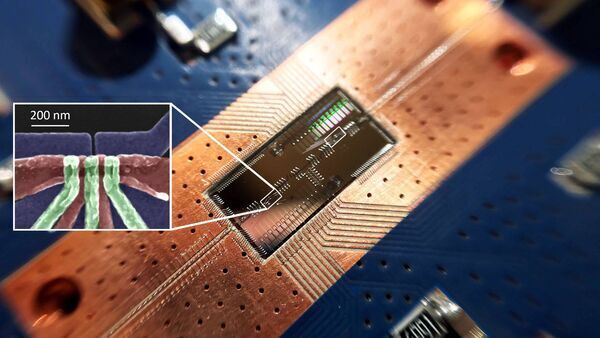
In leap for quantum computing, silicon quantum bits establish a long-distance relationship
"Imagine a world where people could only talk to their next-door neighbor, and messages must be passed house to house to reach far destinations. Until now, this has been the situation for the bits of hardware that make up a silicon quantum computer, a type of quantum computer with the potential to be cheaper and more versatile than today’s versions. Now a team based at Princeton University has overcome this limitation and demonstrated that two quantum-computing components, known as silicon “spin” qubits, can interact even when spaced relatively far apart on a computer chip. The study was published in the journal Nature. “The ability to transmit messages across this distance on a silicon chip unlocks new capabilities for our quantum hardware,” said Jason Petta, the Eugene Higgins Professor of Physics at Princeton and leader of the study. “The eventual goal is to have multiple quantum bits arranged in a two-dimensional grid that can perform even more complex calculations." [...]
Projetos Maker
Diversos Projetos interessantes.
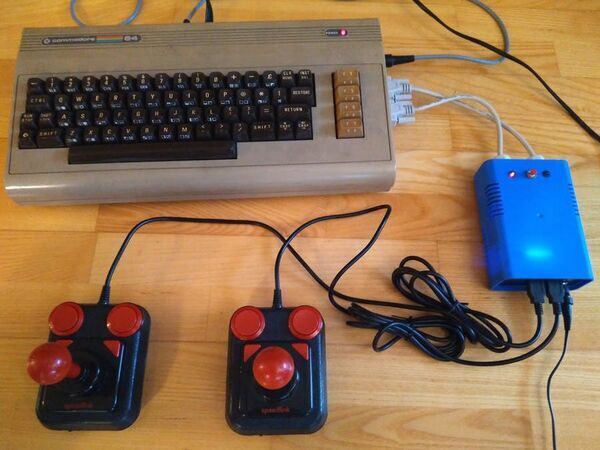
Connect USB Joystick to Commodore C64
"Introduction I own a C64 with Quickshot II Turbo joysticks. Unfortunately the joysticks are worn out. On one, one spring of the micro switch is broken and the micro switches are discrete, which means there is a spring between two poles. Without the exactly matching spring it's not possible to repair. Also the rubber ring which shall bring the joystick back to middle position has dried out over the years. So, buy another pair of used joysticks which are decades old, or find another solution?" [...]
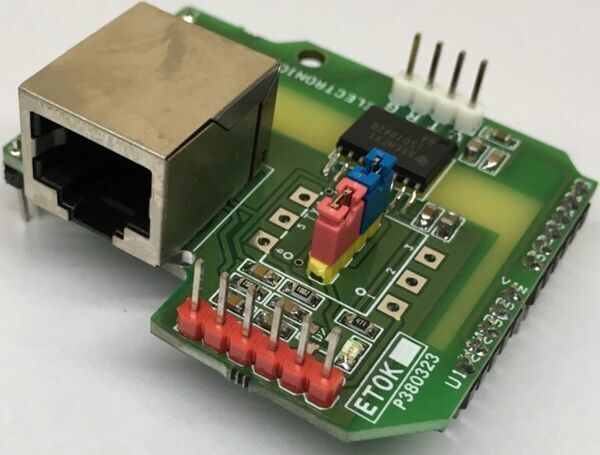
Isolated CAN BUS Transceiver Arduino Shield
"The module described here is an isolated CAN Transceiver module. This module can be used as a standalone module or as an Arduino Uno shield. A controller area network is a two-wire high-speed serial network typically used to provide data communication between host and nodes. The high-speed controller area network transceivers offer integrated isolation, high ESD and high fault protection. The project built using ISO1042 IC from Texas Instruments. The project requires 5V supply from the host side (Arduino) and separates 5V from the node side for isolation." [...]
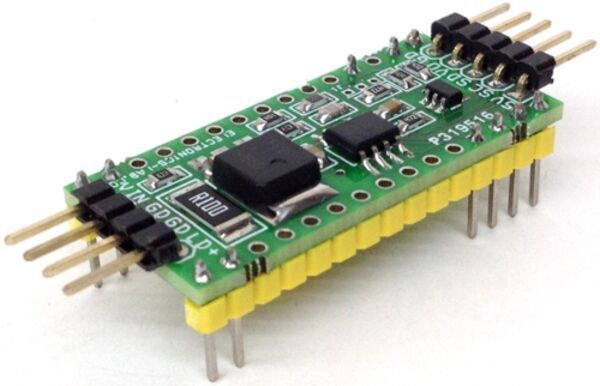
DAC Shield for Arduino Nano using MCP4725
"This project features an easy to use Digital to Analog converter (DAC) shield for Arduino Nano. The project is built using MC4725 12Bit DAC IC over I2C communication. The shield directly seats on Arduino Nano and also can be used as stand-alone DAC converter that can be connected to other micro-controller board with help of 5 pin header connector. Output is 0-5V. PCB jumper J1 provided to select the address in case of using multiple modules on the same I2C . Shield also provided with high current driver circuit, which converters voltage to current and can be used to drive Laser diode or LED." [...]
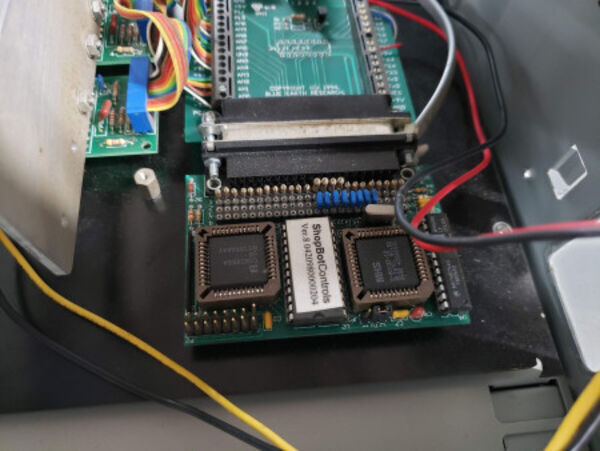
Dumping the x88c64 multiplexed rom
"The 8051 is in everything. I’ve won pitchers of alcohol by betting that a given device contained an 8051. It’s in USB hubs, bluetooth microprocessors, UPSes, and even SOIC16 packages and smaller. That’s not to say it’s a sane architecture, but it’s ubiquitous. The problem I have is pin multiplexing. The 8051 has internal rom, that’s all fine if you’re only using that internal space but the 8031 is the rom-less version." [...]
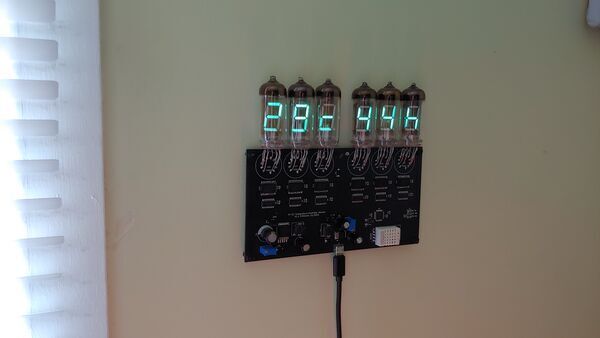
Temperature and Humidity Meter Using IV-11 VFD Tubes
"The displays are driven with a daisy chained shift register. The converter on the left generates the 24V rail and the centre converter provides 1.5V for the filaments. Both converters can be disconnected via jumper for initial setup and programming. Sensor is a DHT22 controlled with an ATMega328p microcontroller. " [...]

The Tile Tapper
"A TI MSP430-based robot that uses photoresistors to sense piano tiles and servo motors to tap them on an iPad screen. The Tile Tapper is an entirely TI MSP430-controlled robot designed to play the iPad application "Piano Tiles". To do this, photoresistors are used to determine whether a given tile passing across the screen is black or white. This information is then used by the four corresponding motors to tap the styluses and hit the tiles at the correct time. TheCode Timer A: Happening in the MSP430 Timer A, the ADC10 DTC (Analog-to-Digital Converter, Data Transfer Control) is used to read the four photoresistors and send their values to a global four element integer array once every 0.5 ms. In the ADC10 ISR (Interrupt Service Routine), these four photoresistors are correlated with specific motors and given thresholds for their readings." [...]

DumbDumb
"A little smart hardware terminal for use with REPLs like MicroPython in the form of a Feather Wing. A boot-to-python battery-powered handheld. It understands just enough VT100 terminal commands to work with the MicroPython REPL. This is the MVP. If I spin another iteration of the prototype I will add or change the following: Larger 480x320 display rather than 320x240 because the text is too small to be comfortable to read. Can use a larger font, but then fewer characters will fit." [...]
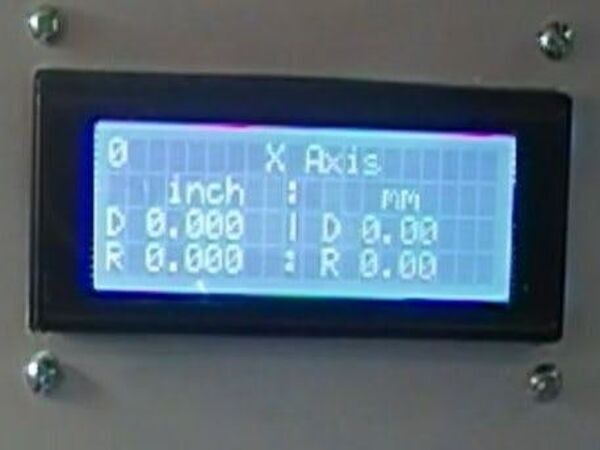
Do It Yourself Digital Read Out
"Make your own custom DRO that measures distance for lathes, milling machines, wood working tools, cut off saws and other purposes. I decided to build an inexpensive rugged custom Digital Read Out for myself and for other hobbyist. My DRO design is fairly simple, it can be modified to measure short and very long lengths. It also allows the user to modify an Arduino sketch for personal measuring preferences and for the language of their choice. " [...]
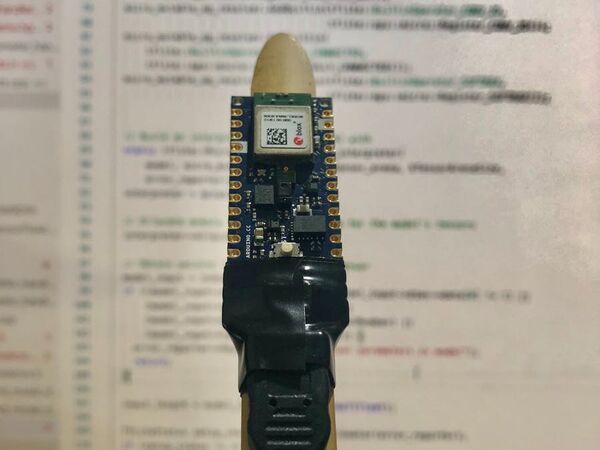
AI-Powered Magic Wand
"A magic wand that uses machine learning to learn and recognize wand gestures, powered by Arduino Nano 33 BLE, TensorFlow, and PlatformIO. Let the magic fills this year's Christmas and upcoming new year. For that, I built a magic wand :) And I use it to properly greet the holidays in a geeky possibly way. What "magical" about this wand is that it uses Machine Learning (ML) to learn and recognise the wand gestures, only from the data collected from accelerometer sensor (that measures acceleration force). By using ML, the wand movement doesn’t have to be precise, it can be still recognised as gesture. Arduino Nano 33 BLE Sense board as the main hardware with ARM Cortex M4 Microcontroller (MCU), is attached on a stick, that functions to collect acceleration data from on-board accelerometer sensor, then process and infer the prediction (hence, inference) of performed gesture, right on the Microcontroller (MCU) itself." [...]

LED Flame With a Plasma Effect
"Controlling LEDs with regular patterns can get old. Even the best can be predictable and a little boring. But controlling them with an algorithm that can create a more organic feel is way more fun and has a nicer result. This Instructable goes over the process of working with the noise algorithm to adjust these effects as much as you want. And of course all the files you need to make your own. What you need to make this: 3D printer Natural PLA Black PLA Arduino-style small microcontroller Battery Switch Neopixel ring M3 hex socket bolts The microcontroller I'm using here is the Pro Trinket." [...]

Eight-Character Alphanumeric Display
"This is an eight-character alphanumeric LED display with an I2C interface. It's based on a low-cost HT16K33 display-driver chip, and supports four two-character 14-segment alphanumeric display modules. Because it has an I2C interface it's easy to drive from pretty much any microcontroller, such as an Arduino Uno, or even an ATtiny85 I also include a display interface that provides a print() class that allows you to print strings and numbers to the display, with automatic scrolling. This lets you use the display as a convenient alternative to the Arduino Serial Monitor for printing values and results while debugging. The display interface will also work with Adafruit's four-character alphanumeric displays. Introduction I wanted an eight-digit alphanumeric display, for displaying messages for another project which I hope to write about in a future article, and sourced a set of low-cost alphanumeric display modules from AliExpress." [...]
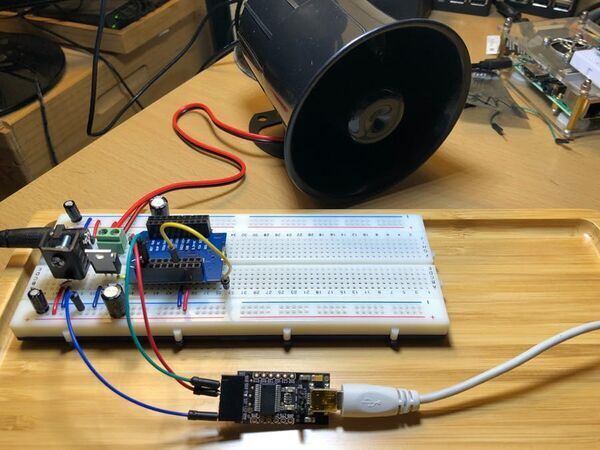
Do It Yourself Siren Alarm Based on ESP32 Wemos D1 R1
"My home automation system needed a loud alarm signal when either "panic" or "fire" was declared by my family. A 12 volt siren was perfect. Story I’ve been building a home automation system for several years. Today, Internet of Thing devices measure the environment in four locations, track movement of people (and cats) throughout the house, turn appliances on and off, integrates with Alexa voice commands, incorporate digital clocks for visual messages, use MQTT messages between devices and Adafruit.io for data analysis. Several IoT devices have piezo buzzers for alarm notification but they were not very loud. A couple of years ago I published an example of one called “Harry’s Horn."" [...]
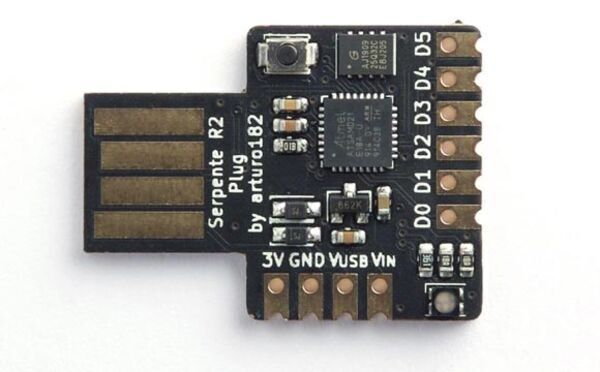
uLisp for Serpente boards
"This is a version of uLisp 3.0 designed to work with the tiny Arturo182 Serpente boards. It's a slightly modified of the ARM version of uLisp; at some stage I may incorporate it into the standard ARM version. For more information about uLisp see: uLisp - Lisp for microcontrollers. I've also created an Arduino Core that is needed by uLisp. You could also use this on its own to program the Serpente boards in C from the Arduino IDE. It's available from https://github.com/technoblogy/serpente-core." [...]

SamyGO
"SamyGO is a project for legal reverse engineering and research on Samsung Television firmwares which is Open Sourced, partially. Enable PVR for Cable TV or Dish Network SamyGO enables PVR on some TV models so users could record their favorite programs. Notice: PVR requires use of internal digital tuner of TV. Dish recording available only for TVs that has DVB-S tuner inside. So Set top box setups not supported. Ask your Satelite Dish or Cable TV Provider if they allows use of internal tuner with Crypt cards." [...]
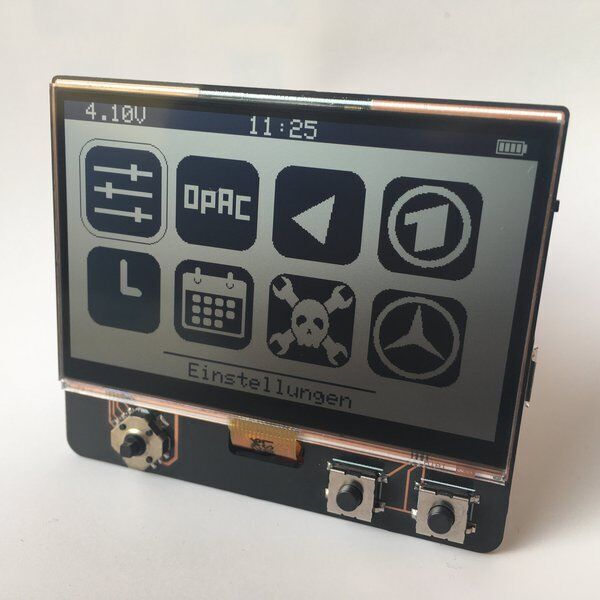
Low Power ESP32 Handheld
"Pocket sized ESP32 display board with 300W Always On Display This handheld board is powered by an ESP32 and features a transflective Sharp memory LCD. Similar to my previous Chronio smartwatch the focus of this project is on low power consumption. Using the ESP32's ULP core, the board can go into deep sleep with an active display. The software includes a menu interface with a simple RSS reader. Some of the key features are: - 400x240px 2.7" SHARP memory display - 350 mAh LiPo battery with USB charging - Always On Display with 300 µW power consumption - 4-way joystick and buttons - Date and time using built in RTC with NTP sync - RSS Feed / Website parser Layout files and Code on GitHub: https://github.com/CoretechR/ESP32-Handheld" [...]
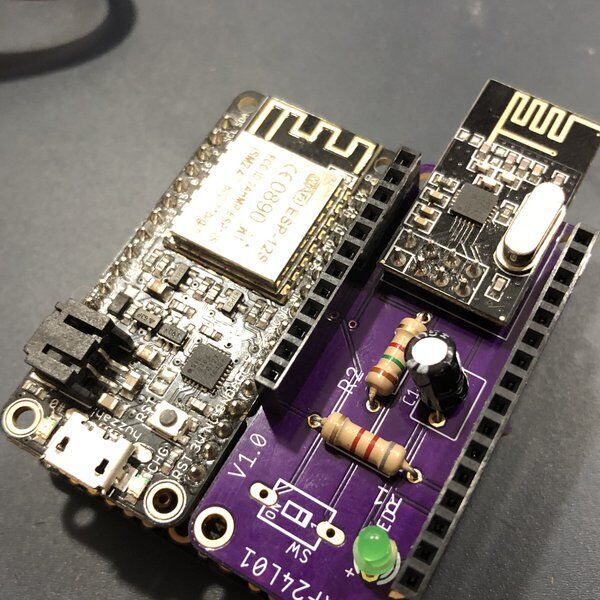
nRF24L01+ Feather Wing Shield
"This Feather Wing board integrates the nRF24L01+ module & allows it to communicate with other nRF24L01+ modules for low power data exchange. Now you can use your Feather board to make use of the nRF24L01+ 2.4ghz wireless module. It works great to create a wireless network for module-to-module data exchange. The nRF24L01+ is great at low power applications and running off a battery. The wing also features a switch to tie the nRF24L01+ IRQ pin to a input for interrupt use. It can be switched off to free up a GPIO if needed." [...]
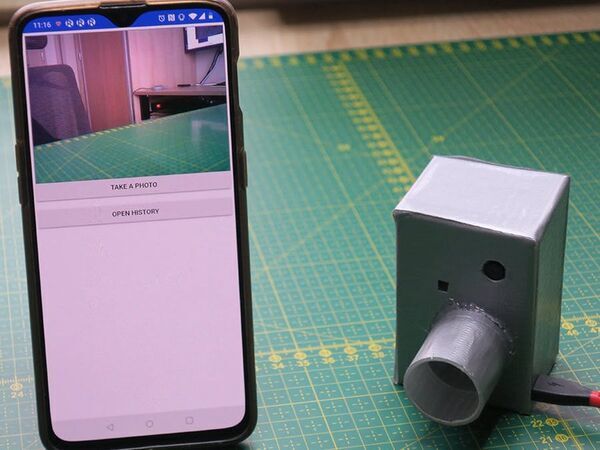
Motion Detector, with Photo and Mobile Notification
"When motion is detected, a photo will be taken and a notification sent. There is also a button to take a photo whenever you want. Motion detector, with photo and mobile notification Introduction The assumptions of the project are quite obvious – when motion is detected, a photo will be taken and a notification with the photo will be sent to the smartphone. Photos can be viewed and access not only from the local network but also from anywhere where there is internet. Pictures can also be taken at any time by pressing the button in the application / on the webpage. The program itself on ESP has settings that limit the number of photos taken when motion is detected and by default it is 2min – which can be easily changed." [...]

Bit Preserve
"Project for capturing vintage, classic, aka old computer schematics in KiCad. Recreating classic computer schematics. Let's convert all those random scanned PDFs into a modern, editiable and re-usable format. Most of the directories are empty. They represent the structure I had initially had in mind. I'm working on the Apple IIgs ROM3 schematic." [...]

Build your child a wooden MP3 player for $100
"This repository contains the files required to build an easy to use MP3 player for small children. This project is heavily inspired by Hoerbert. Main components required to build: - Arduino Uno - Adafruit Music Maker shield - Speaker - Button PCB (see below) - Volume Pot - On/Off switch - Battery holders - Hookup wire" [...]

Piet
"Piet is a programming language in which programs look like abstract paintings. The language is named after Piet Mondrian, who pioneered the field of geometric abstract art. I would have liked to call the language Mondrian, but someone beat me to it with a rather mundane-looking scripting language. Oh well, we can't all be esoteric language writers I suppose. Notes: - I wrote the Piet specification a long time ago, and the language has taken on a bit of a life of its own, with a small community of coders writing Piet programs, interpreters, IDEs, and even compilers. I have not written any "authoritative" interpreter, and the different ones available sometimes interpret the specification slightly differently." [...]

Build an Ioniser in under $10
"This is a project which I wanted to do around 2 years back but never got around to building it. It’s nothing too fancy or super high tech. Anyone with some DIY capabilities should be able to pull this off without breaking a sweat. I have open-sourced the entire design, Bill of materials and you should be to order the parts and build one for yourselves in under $10. You can download the hardware files here. Check out the device in action here." [...]
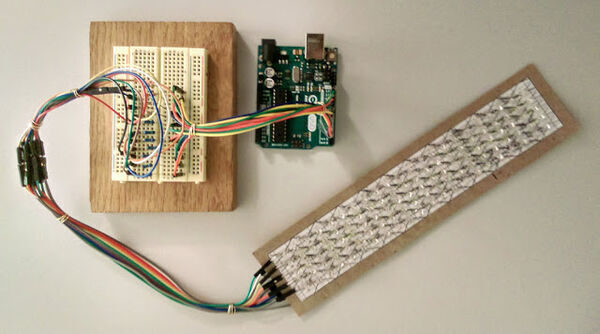
Building a 'papercraft' LED marquee
"Long, dark winter nights demand some tinkering and crafts. Arduino LED projects are fun, but custom circuit boards might not always be in the budget. Thankfully, discrete LEDs can be found on Ebay for less than 1¢ apiece, and cardboard circuits are a thing. Can we build a scrolling marquee display with nothing more than some LEDs, cardboard, and paper? APPROACH We'll lay out and solder our LED marquee on cardboard, and build some dividers to separate pixels, and print a little screen on top to diffuse the light. We will use a "Charlieplexing" layout to control many LEDs using only a few pins." [...]

DIY ‘Meta Clock’ with 24 Analog Clocks
"The year 2019 is coming to an end, so it is perfect time to finish a project I have working on for the last few weeks: a ‘meta clock’ built with 24 individual analog clocks, controlled by a network of LPC microcontrollers. The idea of using multiple analog clocks to build a meta clock is not new: The Swedish design studio ‘Human since 1982‘ has created different versions of awesome and stylish clocks in the ‘ClockClock’ project. Design Considerations and Limitations Such a clock can be built in many ways. For my design I considered the following: - Costs: I did not aim for the lowest possible costs, but it still shall be reasonable, aiming at less than $10 for a single clock. - Time: Using fiducials on the board to use a Pick&Place machine to produce the boards - Power: The clock shall operate from standard 5V (e.g. USB power bank) and be less than 2A for a 24 clock version." [...]

Current Source DAC AD5420 and Arduino UNO
"Current Source DAC AD5420 and Arduino UNO Hello.In this article, I would like to share my experience with the AD5420 current digital-to-analog converter, which has the following characteristics: 16-bit resolution and monotonicity Current output ranges: 4 mA to 20 mA, 0 mA to 20 mA, or 0 mA to 24 mA ±0.01% FSR typical total unadjusted error (TUE) ±3 ppm/°C typical output drift Flexible serial digital interface On-chip output fault detection On-chip reference (10 ppm/°C maximum) Feedback/monitoring of output current Asynchronous clear function Power supply (AVDD) range 10.8 V to 40 V; AD5410AREZ/AD5420AREZ 10.8 V to 60 V; AD5410ACPZ/AD5420ACPZ Output loop compliance to AVDD − 2.5 V Temperature range: −40°C to +85°C For work, I took the following components:- Arduino UNO,- AD5420 shield for Arduino (with galvanic isolation),- Multimeter (for measuring the output current). " [...]
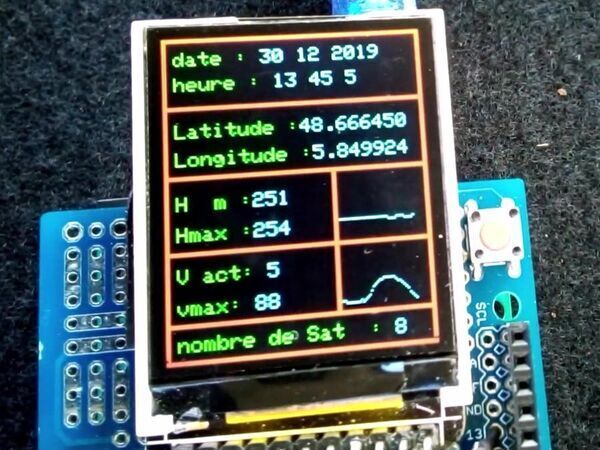
GPS Data Logger, Real-Time Curve, Max Height and Max Speed
"This project describes how to build a GPS data logger at a lower cost. I practice aeromodelling and I like to know the speed and altitude of my planes. unfortunately, commercial data logger gps are very expensive. So I decided to make a data logger gps based on arduino for a cost less than 50 €. My first prototype is based on aruino uno R3 with a sainsmart ST7735 screen with integrated SD card and a NEO 6M V2 gps module. In the second project I would use an arduino nano with an oled ssd1306 screen, the same gps and a micro SD card." [...]
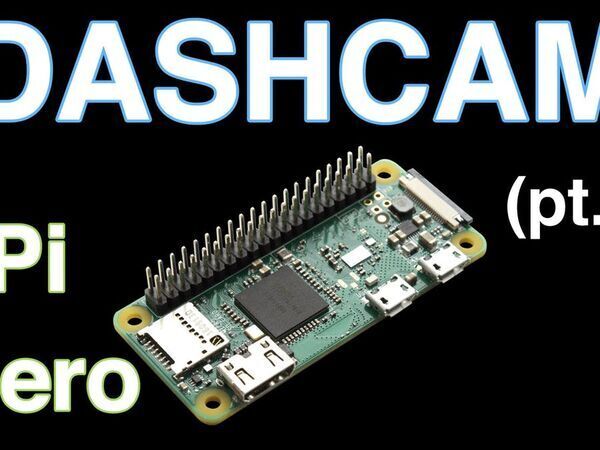
Making a DashCam Using the Raspberry Pi Zero
"This is the start of a new series where we learn how to build a dashcam using the Raspberry Pi Zero. This is the start of a new series where we learn how to build a dashcam using the Raspberry Pi Zero. This project is actually a continuous video recorder and can be used for other applications including wildlife monitoring. In part 1, we tackle the recording section, which involves capturing video from the Pi camera and storing it to the microSD card. We also take care of file numbering, detecting remaining storage, stopping the script if it is low and we also add the FTP functionality to access the files remotely. The first thing we need to do is download the Raspbian operating system for the Raspberry Pi." [...]

i.MX RT1010 EVK RGB LED Matrix Driver
"Drive a 32x32 RGB LED matrix with the NXP i. MX RT1010 EVK. NXP i.MX RT1010 EVK RGB LED Matrix Driver Drive a 32x32 RGB LED matrix with the NXP i.MX RT1010 EVK. Any matrix that is drop-in compatible with the Adafruit 1484 will work. " [...]
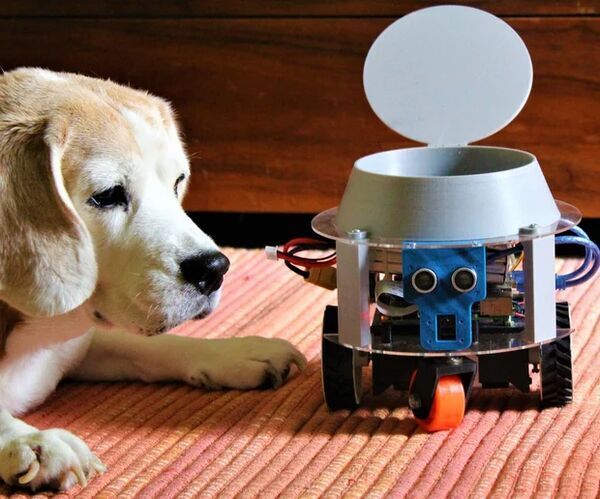
Arduino and Raspberry Pi Powered Pet Monitoring System
"Recently while on vacation, we realized the lack of connection with our pet Beagle. After some research, we found products that featured a static camera that allowed one to monitor and communicate with one's pet. These systems had certain benefits but lacked versatility. For example, each room required a unit to keep track of your pet across the house. Therefore we developed a robust robot that can maneuver around the house and can monitor one's pet using the power of the internet of things. A smartphone app was designed to interact with your pet via a live video feed." [...]

A Tiny Bass Preamp and Effects Box: Black Ice, Electra Fuzz
"In this guide I will show how you can make your very own bass/guitar pre-amplifier and effects box. I choose to make a hybrid effect box, which mixes the common Black Ice or Electra Distortion distortion effect with the Bazz Fuss fuzz effect. This is combo is great at making you sound like a rock/grunge star. Meanwhile the pre-amplifier makes the input much, much, louder for that added oompf. Disclaimer: This is a very difficult project to attempt if building it to such a small form factor. I do not recommend trying to make it as small as I made it." [...]
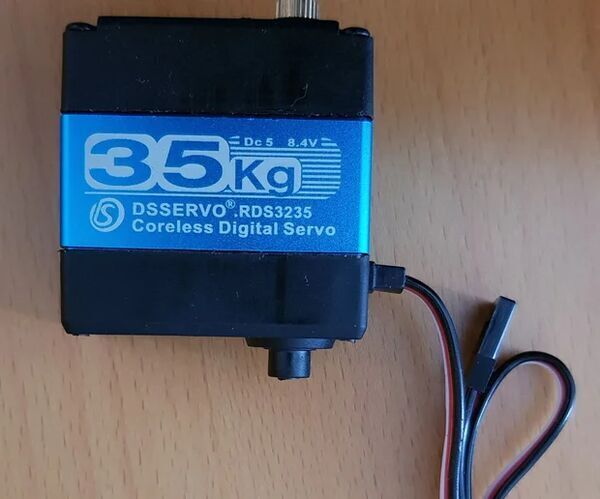
How to Mod a Servo to Get Closed Loop Feedback
"While driving a servo with a microcontroller (as Arduino), you can only give him orders of target location (in PPM signal). With this order, the servo will move to this target location. But it's not instantaneous! You don't know exactly when the location will be reached... This is open loop control. If you need to move to different locations in sequence, the usual way is to insert pauses (delay instructions) in order to let the servo achieve the move." [...]
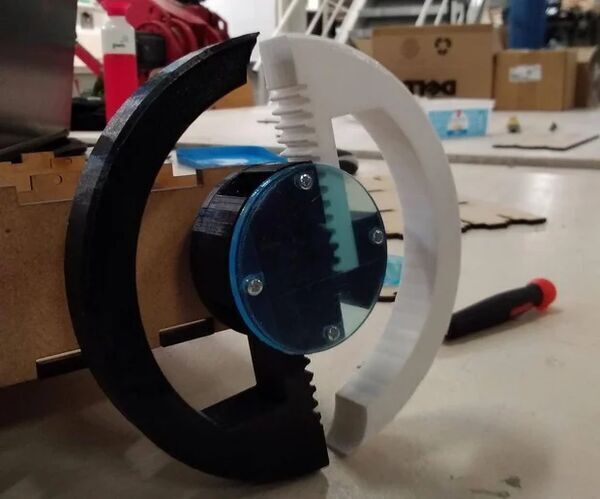
Adaptive Field Robot
"Have you ever dreamed to design a robot able to overcome obstacles? Then launch that robot in the space with a SpaceX rocket? And finally explore a new planet and collect incredible datas that will change the future of Humanity? Then this 'Instructables' is for you. Well, maybe you won't save humanity at the end of this project BUT you will have a two wheel drive Adapting field Robot, which is pretty sweet. The project happened in the context of the Bruface programme." [...]
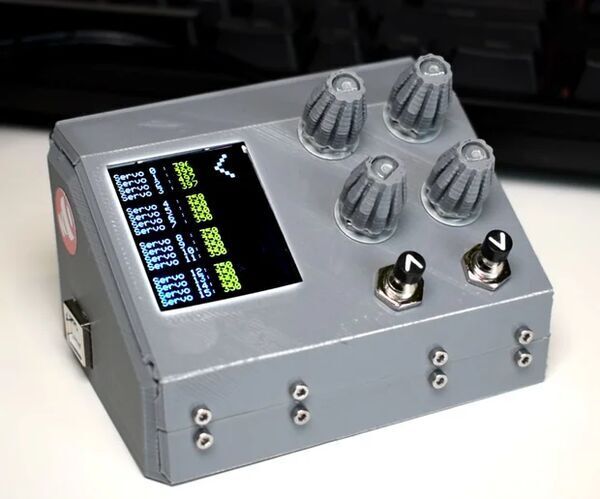
16 Channel Servo Tester With Arduino and 3D Printing
"Pretty much every project I've done just lately has required me to test out some servos and experiment with their positions before they go into the assembly. I usually make a quick servo tester on a breadboard and use the serial monitor in the arduino IDE to get the servo positions, but this time I decided I'd treat myself and design an enclosed, permanent system to test my servos! The design can control 16 servos simultaneously, using the Adafruit PCA9685 servo driver board. In order to save space, it only has 4 potentiometers for adjustment and a seperate set of switches are used to select the set of four you'd like to control. One problem I encountered in early prototypes was that the design was pretty hard to solder and then cram into a little box, so this most recent design is printed flat, soldered and folded up, making it super easy to assemble! I used good quality potentiometers with an M9 mounting hole, but if you'd like to modify the Fusion 360 assembly to fit your requirements, feel free to download the file: https://a360.co/2Q366j4 (or just drill it bigger)." [...]

Adjustable Double Output Linear Power Supply
"Features: - AC – DC Conversion Double output voltages (Positive – Ground – Negative) - Adjustable positive and negative rails - Just a Single-Output AC transformer - Output noise (20MHz-BWL, no load): Around 1.12mVpp - Low noise and stable outputs (ideal to power Opamps and Pre-amplifiers) - Output Voltage: +/-1.25V to +/-25V Maximum output current: 300mA to 500mA - Cheap and easy to solder (all component packages are DIP) A double output low noise power supply is an essential tool for any electronics enthusiast. There are many circumstances that a double-output power supply is necessary such as designing pre-amplifiers and powering OPAMPs. In this article, we are going to build a linear power supply that a user can adjust its positive and negative rails independently. Moreover, just an ordinary single-output AC transformer is used at the input. " [...]
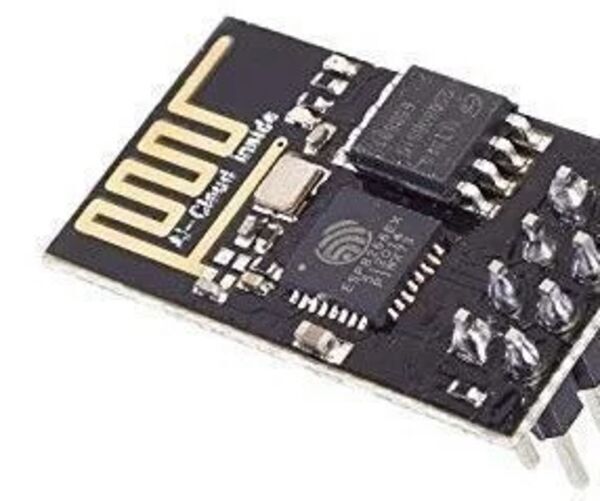
Restore or Upgrade Firmware on ESP8266 (ESP-01) Module Using Arduino UNO
"The ESP-01 module that i used originally came with older AI Thinker firmware, which limits its capabilities since many useful AT commands are not supported. It is generally a good idea to upgrade your firmware for bug fixes and also depending on the functionalities needed from the ESP module, a more complete set of supported AT commands might be required. This tutorial also explains how to restore or flash original Espressif firmware if you happen to mess up your ESP firmware, for example, through some wrong AT commands. This is what happened when i tried to change the default baud rate from 115200 to 9600. I used the following command (based on a quick Google search): AT+IPR=9600This bricked the ESP-01 module. No AT commands worked anymore, which prompted me to do more research and after many hours, i finally found a way to restore my ESP-01 and install the latest compatible firmware." [...]
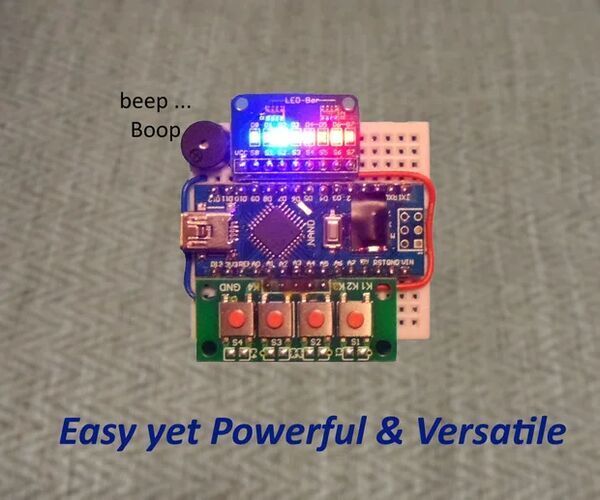
Mini STEM LED Game Platform
"Simple mini STEM (Science Technology Engineering and Math) project platform, which can be used as the basis for an educational STEM/maker class in elementary, summer camp or middle school. Let's not forget about home tutoring. No soldering, hot iron or glue gun is needed. In addition, it is very inexpensive lending itself to use in a large class room setting. I have also created a software development instructional, set of lessons, which utilizes this hardware platform. Given here: STEM-Game-Platform Lesson Plan This build is also just a lot of fun for kids." [...]

Solar USB Charger
"This 3D printed solar USB charger is inexpensive and easy to make. It's compatible with almost any device that charges via USB. In direct sunlight it is capable of charging the internal battery at about 500 mah, and can deliver 1000 mah to devices. Here's the tools and supplies you'll need: Tools: Fine tip soldering iron and solder Epoxy or super glue Scissors or wire cutters Supplies: 3D printed enclosure PowerBoost 500 charger 2.5w solar panel Panel mount USB port 1N4001 blocking diode Lithium ion battery and battery holder Panel mount power button Hook up wire" [...]

DIY Arduino Calculator Using OLED Display
"in one of my previous Instructable tutorial, we learnt how to interface an OLED with Arduino and basics of it, now its time to step up the game and make some project based on OLED, so in this tutorial, we will learn how to make a simple yet slinky calculator based on Arduino! Supplies: A.Components OLED Display Arduino Arduino Keypad 3.7v, 200mAH Lithium Polymer Battery Switch B. Tools Soldering Iron hot glue gun Soldering Wire Wire Stripper C. Software 1. Arduino IDE" [...]
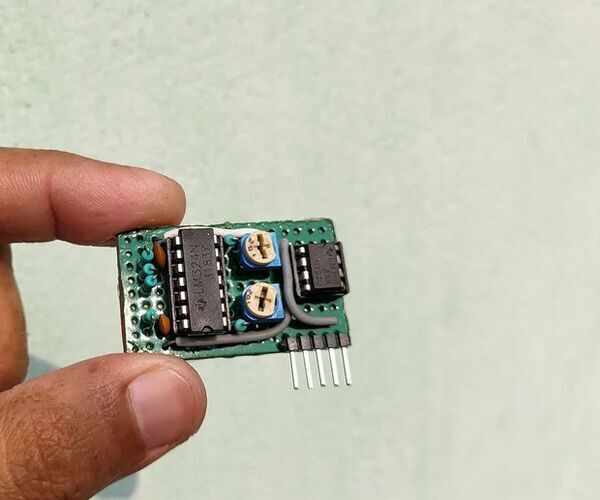
SPWM Generator Module (without Using Microcontroller)
"Hello everyone,welcome to my instructable! I hope you all are doing great. Recently, I got interested in experimenting with PWM signals and came across the concept of SPWM (or Sinusoidal Pulse Width Modulation)where the duty cycle of a train of pulses is being modulated by a sine wave. I came across a few results where such kind of SPWM signals can easily be created using a microcontroller where the duty cycle is being generated by using a lookup table that contains the necessary values to implement the sine wave. I wanted to generate such SPWM signal without microcontroller and thus I used Operational Amplifiers as the heart of the system. Lets get started!" [...]
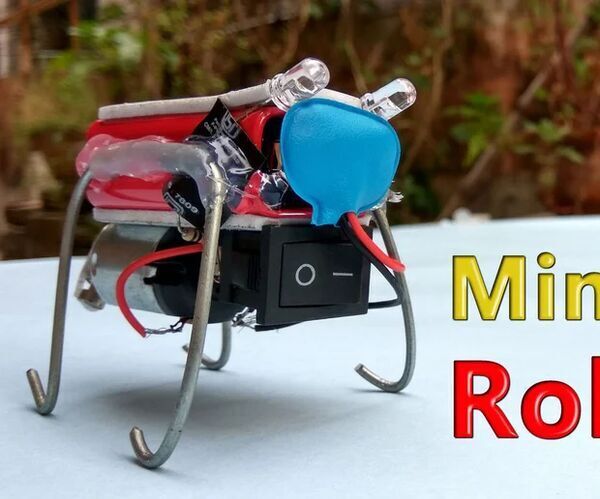
How to Make a Mini Bug Robot in 5 Minutes
"In this project, we will make a simple tiny bug robot using some basic components. You will need 5 to 10 minutes to make this simple moving mini bug robot. Supplies:1. a DC motor [5-9v] [or a vibration motor from an old mobile set can be used instead] 2. Switch 3. 9 v Battery with clip 4. LEDs [Red 2 nos] 5." [...]
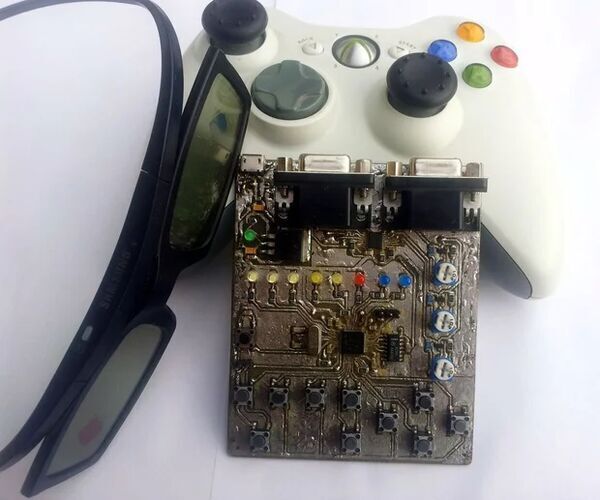
Alternately Occluding Dichoptic Modifier of Stereoscopic Transmission 32 - STM32F103C8T6+STMAV340 VGA Superimposer
"For some time Ive been working on a successor to to the original AODMoST. New device uses faster and better 32-bit microcontroller and faster analog video switch. It allows to AODMoST 32 to work with higher resolutions and implement new functionalities. Device can now also be powered by USBs 5V voltage. Biggest new feature is implementation of simple patterned image mask for one eye and inverse patterned mask for the other one, similar to the one presented in this article: Dichoptic movie viewing treats childhood amblyopia. There are also more customization options for the shape, position and constant randomization of those parameters." [...]
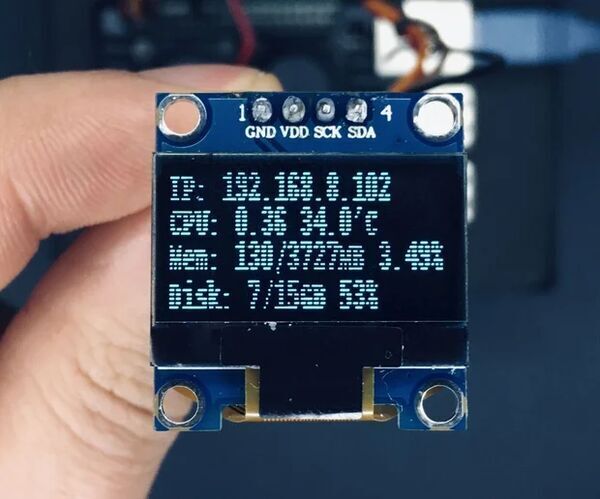
Raspberry Pi Monitoring System Via OLED Display Module
"In this tutorial Ill explain how to setup 0.96 inch OLED display module for showing system information of Raspberry Pi 4 Model B using its I2C interface. Supplies: Hardware Required: Raspberry Pi 4 Model B 128×64 OLED display module (SSD1306) Connecting Wires" [...]
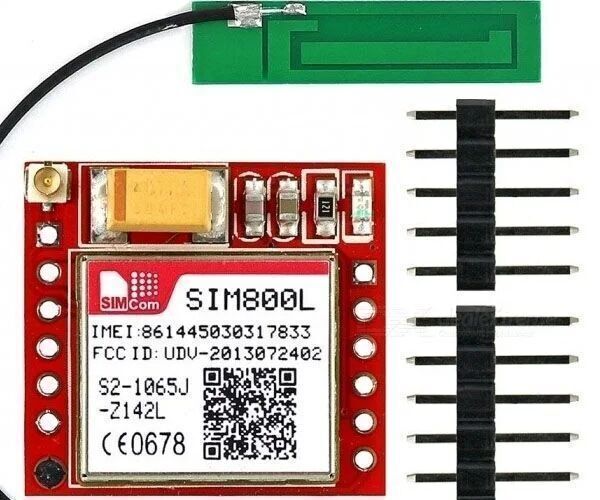
How to Use SIM800L to Send SMS and Control Relay by SMS
"Description: This tutorial is showing how to use SIM800L to send sms and receive sms to control relay. SIM800L module is small in size and can be used to interface with Arduino to send sms, receive sms, call, receive call and else. In this tutorial, we only focus on send sms and control relay by receiving sms. Specfication: GPRS multi-slot class12 connectivity: max. 85.6kbps(down-load/up-load) GPRS mobile station class B Controlled by AT Command (3GPP TS 27.007, 27.005 and SIMCOM enhanced AT Commands) Supports Real Time Clock Supply voltage range 3.4V ~ 4.4V Supports A-GPSSupports 3.0V to 5.0V logic level Low power consumption, 1mA in sleep mode Compact size 23mm x 35mm x 5.6mm List Of Material: Arduino UNO Arduino SIM800L GPRS GSM Module DC-DC Adjustable Step Down Converter Power Module Female - Male Jumper Wire Arduino Push Button (Green) B3F Single Channel 5V Relay Module Pin Header Module (Series Connector)" [...]

Room Control With ESP8266 | Temperature, Motion, Curtains and Lighting
"This project consist on a system based on the NodeMCU ESP8266 module that let you control the brightness of a LED Strip and the curtain of your room, also it's able to send data about the motion events of your room and the temperature to the cloud where you can see it by Ubidots IoT platform. Supplies: Ubidots Account: http://bit.ly/2GNDBnl 1x ESP8266 NodeMCU 1x 12v Power Jack 1x 220 ohm Resistor 1/4W 2x Capacitors 120nf 1x Power Transistor TIP31 1x Voltage Regulator lm7805 1x PIR Sensor HC-SR501 1x Temperature sensor DS1820 1x DC Motor Driver L293D 2x Terminal Blocks 1x SIL Female Connectors" [...]

Seeds Sowing Robot
"According to Food and Agriculture Organization of the United Nations, worlds population is expected to grow to almost 10 billion by 2050, boosting agricultural demand. This implies an urgent need to automate the Agricultural sector to gain in productivity and effeciency. From above mentioned, the project of building a Seed Sowing Robot as a solution to agricultural constrains was put in place. The aim of this project is complety automate sowing of seeds by eliminating human labor and increasing production.. This Instructable aims to guide you through the process of creating a seed sowing robot. Project was designed and engineered as part of our Bruface Mechatronics project and has been realized by: - Ahmad Nasrallah - Federico Lucca - Alessandro lupi - Abbas Lakkis - Christian Kamguia - Francesco Fuochi - Ali Moallem Supplies:Step 1: FULL 3D ASSEMBLY Step 2: LIST OF PARTS Step 3: ELECTRONIC PARTS DESCRIPTION Step 4: LASER CUT PARTS Step 5: 3D PRINTED PARTS Step 6: TESTING AND TUNNING OF ELECTRONIC PARTS Step 7: CIRCUIT ASSEMBLY Step 8: FLOW CHART Step 9: CODE USED TO RUN OUR ROBOT" [...]
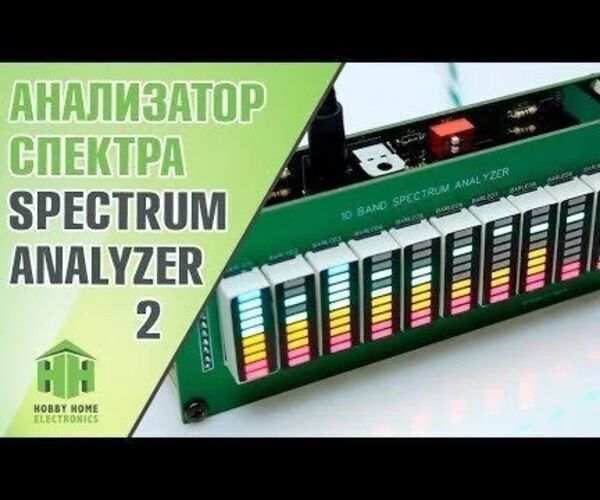
10 Band Led Spectrum Analyzer
"Good afternoon, dear viewers and readers. Today I want to show you the complete assembly guide for the 10 band LED spectrum analyzer. Brief Overview of the Technical Features of the Spectrum Analyzer. 1.The reading value is in the frequency range from thirty-one hertz to sixteen kilohertz. 2.Dimensions of the LED matrix: ten rows per ten columns. 3.Possible operating modes: dot, dot with peak hold, line, line with peak hold." [...]

Turret Gun
"Like every mechanical engineer, at one point of our studies we were so tired/upset of everything not working or not going as intended that we wanted to shoot something. What if we are able to make a project that converts all our frustration into something enjoyable and satisfying? Here we present Billy, emperor of destruction, lord of the guns, ally of Nerf company. The point of this project was to use our creativity to build a robot. Shooting an object is a very challenging task. In previous project the idea consisted shooting a ball or a dart." [...]

Beach Cleaning Robot (garbage Collector) !!
"Imagine that you decide to go to the beach on a sunny day, to relax your mind and recharge your energy. Sounds awesome! Unfortunately, as you arrive to the beach, you will be shocked by the tremendous amount of garbage thrown in the sand. Bottles and cans of all sizes are thrown here and there by apathetic people. Beach pollution is a very serious issue as we go to the beach to enjoy the environment and not to sit on bottles and cans. It harms and pollutes the environment, animals and humans." [...]

Let's Make the BackpAQ Personal Air Quality Monitor
"The BackpAQ Project The BackpAQ project is part of a middle and high school STEM curriculum that promotes learning about and experience with the monitoring of air quality (AQ) particularly in disadvantaged communities, and drives engagement among underrepresented youth in STEM activities. Key to the program is deployment of a suite of community-based mobile air quality monitors that leverage new low-cost sensors. These handheld units can be readily assembled by advanced middle-school and high school students and other STEM-oriented youth who are motivated by interest in obtaining, understanding and sharing hyper-local air quality data. What we'll build These student-built monitors, encased in a lightweight polycarbonate box, weigh less than a pound and are powered by rechargeable LiPo batteries. They feature carabineers and nylon straps for easy fastening to a backpack or bicycle frame. What well measure As designed, the monitors will measure and display criteria pollutants PM1, PM2.5, and PM10 concentrations in ug/m3, as well as display the US EPA Air Quality Index (AQI)." [...]

PCB UV LED Array Timer
"That's a kind of project that took a long time to be finished, despite its simplicity! That's because I have used, for a long time, a UV fluorescent lamp box to do my printed circuit boards and I always thought that another one, using UV LED's, could wait once more time to be assembled!... Until now!The main design consists of a wood-covered MDF box, a UV LED matrix board and a PIC microcontroller to control exposure time. All the projecs is described and available below. Supplies: * Laser-cut MDF parts; * light imbuia sheet; * UV LED array; * PIC microcontroller timer circuit. " [...]
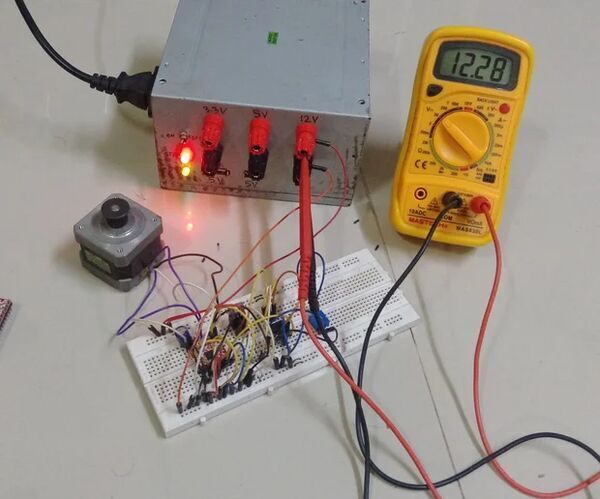
Covert ATX Power Supply to Bench Power Supply
"A bench power supply is necessary when working with electronics, but a commercially available lab power supply can be very expensive for any beginner who wants to explore and learn electronics. But there is a cheap and reliable alternative. By converting a computer ATX power supply that can be found in any discarded computer or can be bought from scrapyard for less than a dollar, you can get a good lab power supply with huge current outputs, short circuit protection and very tight voltage regulation. In this instructable I will show you how to quickly convert any ATX power supply to get a lab power supply with following specifications. An ON/OFF switch Indicator LEDs Output voltages : 12VDC, 5VDC, 3.3VDC Two USB ports with 5VDC output @2A WARNING: YOU ARE WORKING WITH AC VOLTAGE!!! IF YOU ARE NOT SURE OF WHAT YOU ARE DOING - DO NOT ATTEMPT THIS." [...]
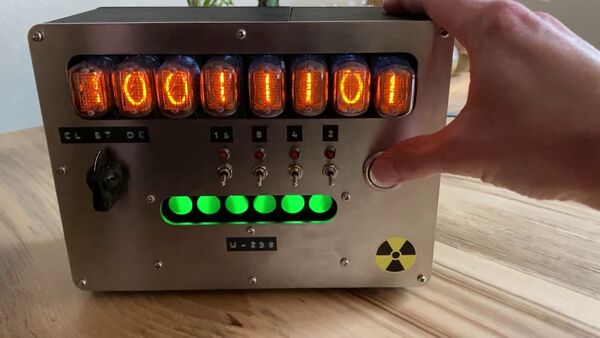
Chernobyl Dice
"The Chernobyl Dice is a quantum random number generator [0] that uses nuclear decays from a weakly radioactive sample as a source of entropy. It consists of four primary components: - An Arduino Nano microcontroller - A Geiger counter - Six uranium glass marbles - Nixie tube display - Geiger counter events ("clicks") are converted into random bits using the following algorithm: In a ring buffer, for each millisecond record either a 0 or a 1, depending on whether or not a Geiger event occurred - Perform an initial de-bias of this 0-dominated stream using von Neumann's method [0] - Further de-bias by XOR-ing bits generated in the previous step with the mod2 of elapsed 4 microsecond intervals since since the device was powered on - The uranium glass sample is illuminated by an array of ultraviolet LEDs at each Geiger event, which makes them fluoresce bright green. This has nothing to do with the radioactivity of the sample, but it does, however, look really cool. Operation The device has three modes of operations, which can be selected via the rotary switch: Clock Mode Displays the current time, with the Geiger board unpowered. The time can be set by flipping the toggle switches on and off (the '16' toggle increments the hour, the '8' toggle increments 10 minutes, the '4' toggle increments 1 minute, and the '1' toggle resets the seconds). Streaming Mode Repeatedly generates random numbers of a size specified by the toggles (or random bytes from 0-255 if no toggles are set)." [...]
That's all Folks!



